小学英语总复习之介词(优质)
- 格式:pptx
- 大小:469.77 KB
- 文档页数:4
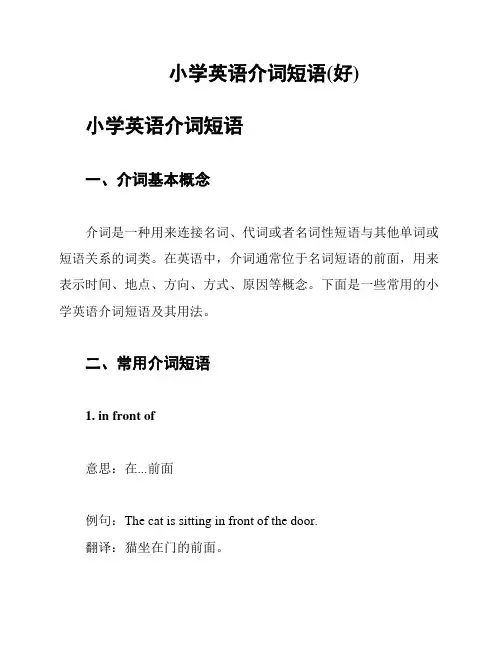
小学英语介词短语(好)小学英语介词短语一、介词基本概念介词是一种用来连接名词、代词或者名词性短语与其他单词或短语关系的词类。
在英语中,介词通常位于名词短语的前面,用来表示时间、地点、方向、方式、原因等概念。
下面是一些常用的小学英语介词短语及其用法。
二、常用介词短语1. in front of意思:在...前面例句:The cat is sitting in front of the door.翻译:猫坐在门的前面。
2. at school意思:在学校例句:I study English at school.翻译:我在学校学英语。
3. on the table意思:在桌子上例句:The book is on the table.翻译:书在桌子上。
4. under the tree意思:在树下例句:We had a picnic under the tree. 翻译:我们在树下野餐。
5. with a friend意思:和朋友在一起例句:I like playing soccer with a friend. 翻译:我喜欢和朋友一起踢足球。
6. by the beach意思:在海滩旁边例句:They built sandcastles by the beach. 翻译:他们在海滩旁边堆沙堡。
7. for breakfast意思:作为早餐例句:I had cereal for breakfast.翻译:我吃了谷物当早餐。
8. after school意思:放学后例句:Let's go to the park after school. 翻译:放学后我们去公园。
9. in the morning意思:在早晨例句:I like to jog in the morning.翻译:我喜欢早晨慢跑。
10. with a smile意思:带着微笑例句:She always greets everyone with a smile.翻译:她总是带着微笑向每个人打招呼。
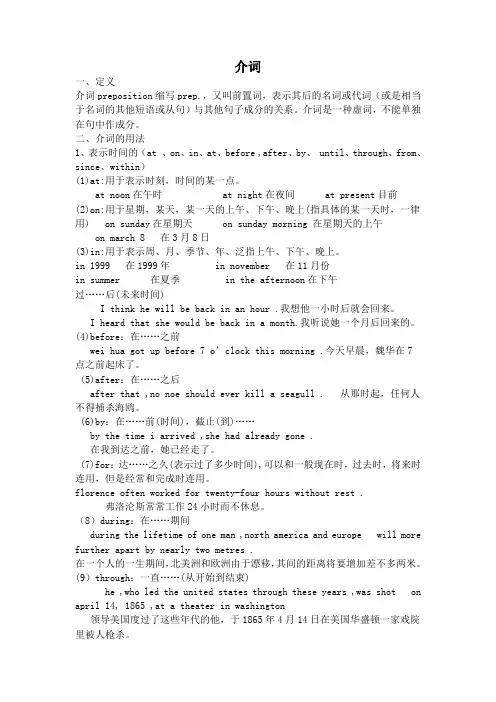
介词一、定义介词preposition缩写prep.,又叫前置词,表示其后的名词或代词(或是相当于名词的其他短语或从句)与其他句子成分的关系。
介词是一种虚词,不能单独在句中作成分。
二、介词的用法1、表示时间的(at 、on、in、at、before ,after、by、 until、through、from、since、within)(1)at:用于表示时刻,时间的某一点。
at noon在午时 at night在夜间 at present目前(2)on:用于星期,某天,某一天的上午、下午、晚上(指具体的某一天时,一律用) on sunday在星期天 on sunday morning 在星期天的上午on march 8 在3月8日(3)in:用于表示周、月、季节、年、泛指上午、下午、晚上。
in 1999 在1999年 in november 在11月份in summer 在夏季 in the afternoon在下午过……后(未来时间)I think he will be back in an hour .我想他一小时后就会回来。
I heard that she would be back in a month.我听说她一个月后回来的。
(4)before:在……之前wei hua got up before 7 o’clock this morning .今天早晨,魏华在7点之前起床了。
(5)after:在……之后after that ,no noe should ever kill a seagull . 从那时起,任何人不得捕杀海鸥。
(6)by:在……前(时间),截止(到)……by the time i arrived ,she had already gone .在我到达之前,她已经走了。
(7)for:达……之久(表示过了多少时间),可以和一般现在时,过去时,将来时连用,但是经常和完成时连用。
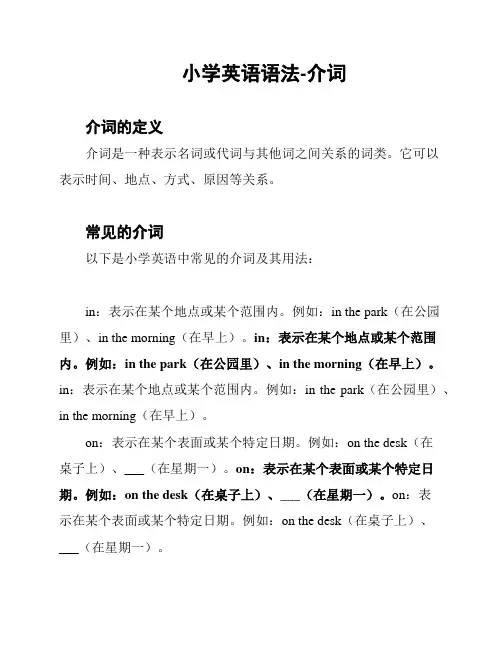
小学英语语法-介词介词的定义介词是一种表示名词或代词与其他词之间关系的词类。
它可以表示时间、地点、方式、原因等关系。
常见的介词以下是小学英语中常见的介词及其用法:in:表示在某个地点或某个范围内。
例如:in the park(在公园里)、in the morning(在早上)。
in:表示在某个地点或某个范围内。
例如:in the park(在公园里)、in the morning(在早上)。
in:表示在某个地点或某个范围内。
例如:in the park(在公园里)、in the morning(在早上)。
on:表示在某个表面或某个特定日期。
例如:on the desk(在桌子上)、___(在星期一)。
on:表示在某个表面或某个特定日期。
例如:on the desk(在桌子上)、___(在星期一)。
on:表示在某个表面或某个特定日期。
例如:on the desk(在桌子上)、___(在星期一)。
at:表示在具体的时间或某个地点。
例如:at 7 o'clock(在7点)、___(在学校)。
at:表示在具体的时间或某个地点。
例如:at 7 o'clock(在7点)、___(在学校)。
at:表示在具体的时间或某个地点。
例如:at 7 o'clock(在7点)、___(在学校)。
to:表示向某个地点或某个目标。
例如:go to the supermarket (去超市)。
to:表示向某个地点或某个目标。
例如:go to the supermarket(去超市)。
to:表示向某个地点或某个目标。
例如:go to the supermarket(去超市)。
from:表示从某个地点或某个时间开始。
例如:___(从星期一到星期五)。
from:表示从某个地点或某个时间开始。
例如:___(从星期一到星期五)。
from:表示从某个地点或某个时间开始。
例如:___(从星期一到星期五)。
by:表示通过某种方式或某个工具。
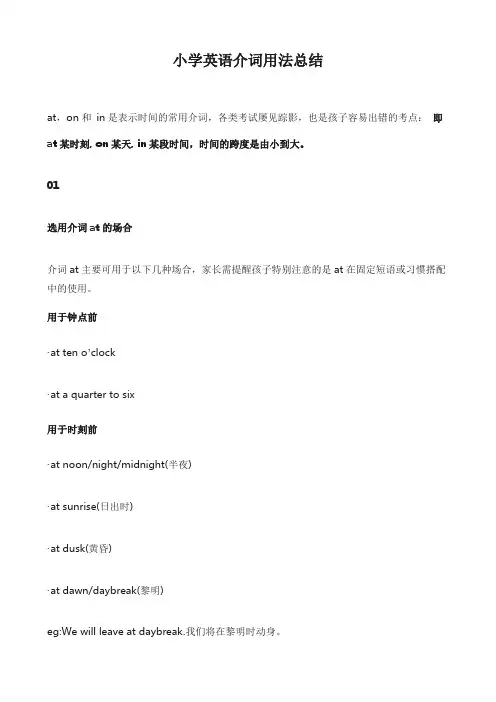
小学英语介词用法总结at,on和in是表示时间的常用介词,各类考试屡见踪影,也是孩子容易出错的考点:即at某时刻, on某天, in某段时间,时间的跨度是由小到大。
01选用介词at的场合介词at主要可用于以下几种场合,家长需提醒孩子特别注意的是at在固定短语或习惯搭配中的使用。
用于钟点前·at ten o’clock·at a quarter to six用于时刻前·at noon/night/midnight(半夜)·at sunrise(日出时)·at dusk(黄昏)·at dawn/daybreak(黎明)eg:We will leave at daybreak.我们将在黎明时动身。
用于表示进餐时间。
如:·at breakfast/lunch/supper(在早餐时/午餐时/晚餐时) eg:He drinks tea at breakfast.他在早餐时饮茶。
用于表示年龄时。
如:·at 14(= at the age of14在14岁)eg: He left home at the age of 16.他十六岁离开了家。
用于一些固定短语或习惯搭配中。
如:·at Christmas·at New Year·at Thanksgiving (感恩节)·at the beginning/end of last month·at the moment/ at that time·at this time of day·at a bad time of year·at first (起初)·at last (终于)02选用介词on的场合用于星期、日期(包括该天的各部分)前·on Sundays/weekdays·on Monday morning / afternoon / eveningeg:I'm flying home on Sunday afternoon. 我星期四下午乘飞机回家。
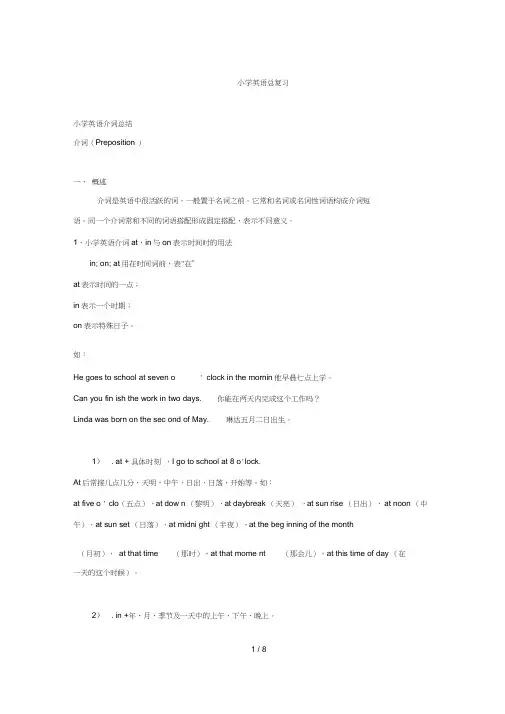
小学英语总复习小学英语介词总结介词(Preposition )一、概述介词是英语中很活跃的词,一般置于名词之前。
它常和名词或名词性词语构成介词短语。
同一个介词常和不同的词语搭配形成固定搭配,表示不同意义。
1、小学英语介词at,in与on表示时间时的用法in; on; at用在时间词前,表"在”at表示时间的一点;in表示一个时期;on表示特殊日子。
如:He goes to school at seven o ' clock in the mornin他早晨七点上学。
Can you fin ish the work in two days. 你能在两天内完成这个工作吗?Linda was born on the sec ond of May. 琳达五月二日出生。
1). at + 具体时刻,I go to school at 8 o'lock.At后常接几点几分,天明,中午,日出,日落,开始等。
如:at five o ' clo(五点),at dow n (黎明),at daybreak (天亮),at sun rise (日出),at noon (中午),at sun set (日落),at midni ght (半夜),at the beg inning of the month(月初),at that time (那时),at that mome nt (那会儿),at this time of day (在一天的这个时候)。
2). in +年、月、季节及一天中的上午、下午、晚上。
in 2006 (2006 年),in May , 2004 (2004 年五月),in the morning (早晨/上午),inthe after noon (下午),in the evening (晚上),in the ni ght (夜晚),in the daytime(白天),in the 21st century (21 世纪),in three days (weeks/month )三天(周/个月),in a week (一周),in spri ng (春季)。
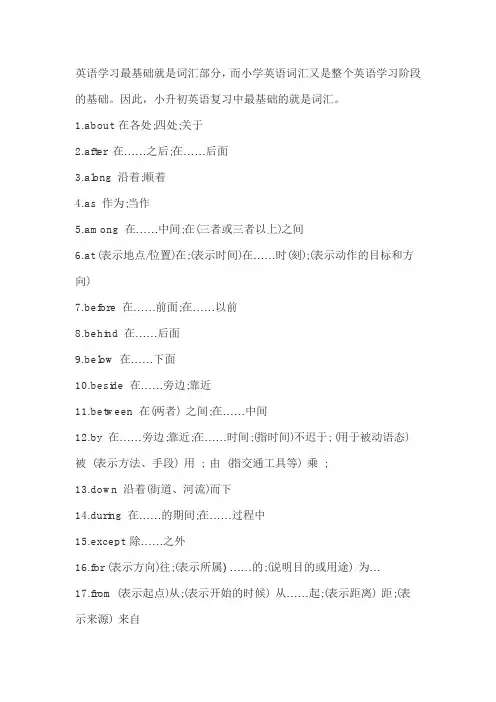
英语学习最基础就是词汇部分,而小学英语词汇又是整个英语学习阶段的基础。
因此,小升初英语复习中最基础的就是词汇。
1.about 在各处;四处;关于2.after 在……之后;在……后面3.along 沿着;顺着4.as 作为;当作5.among 在……中间;在(三者或三者以上)之间6.at (表示地点/位置)在;(表示时间)在……时(刻);(表示动作的目标和方向)7.before 在……前面;在……以前8.behind 在……后面9.below 在……下面10.beside 在……旁边;靠近11.between 在(两者) 之间;在……中间12.by 在……旁边;靠近;在……时间;(指时间)不迟于; (用于被动语态) 被(表示方法、手段) 用; 由(指交通工具等) 乘;13.down 沿着(街道、河流)而下14.during 在……的期间;在……过程中15.except 除……之外16.for (表示方向)往;(表示所属) ……的;(说明目的或用途) 为…17.from (表示起点)从;(表示开始的时候) 从……起;(表示距离) 距;(表示来源) 来自18.in front of 在……前面19.into (表示动作的方向)到……内;(表示情况和结果的变化)变成20.in (表示位置)在…里/内/中;在…(时间) 穿;戴在…(情况/ 状况) 中;使用(语言)21.like 像22.near 在……附近;靠近24.off (表示脱离)离开23.of (表示所属关系)…的;表示数量)…的;(表示其中)…的25.on 在……上面;在……时刻;关于26.over 在……上方(以上);越过;遍及27.past (指时间)过;走过某处28.since 自从…以来29.through 穿过;通过;从开始到结束30.till 直到……为止31.until 直到……为止32.up 在/向……上面33.to (表示方向)到,向;(表示间接关系) 给; (表示钟点) 在……之前34.with (表示具有)带有;(表示手段或方法)用;(表示伴随) 与…一道;和…一起35.without 没有36.round 环绕一周;围着37.under 在/向……下面。
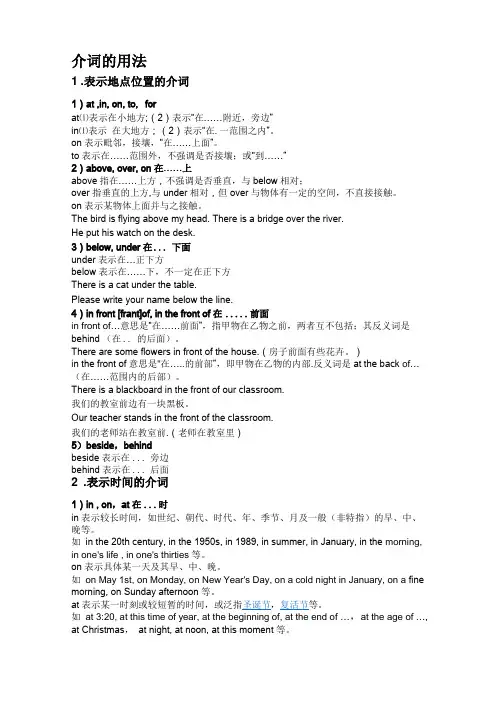
介词的用法1 .表示地点位置的介词1)at ,in, on, to, forat⑴表示在小地方;(2)表示“在……附近,旁边”in⑴表示在大地方;(2)表示“在.一范围之内”。
on表示毗邻,接壤,“在……上面”。
to表示在……范围外,不强调是否接壤;或“到……”2)above, over, on 在……上above指在……上方,不强调是否垂直,与below相对;over指垂直的上方,与under相对,但over与物体有一定的空间,不直接接触。
on表示某物体上面并与之接触。
The bird is flying above my head. There is a bridge over the river.He put his watch on the desk.3)below, under 在... 下面under表示在…正下方below表示在……下,不一定在正下方There is a cat under the table.Please write your name below the line.4)in front [frant]of, in the front of 在..... 前面in front of…意思是“在……前面”,指甲物在乙物之前,两者互不包括;其反义词是behind (在.. 的后面)。
There are some flowers in front of the house.(房子前面有些花卉。
)in the front of意思是"在…..的前部”,即甲物在乙物的内部.反义词是at the back of…(在……范围内的后部)。
There is a blackboard in the front of our classroom.我们的教室前边有一块黑板。
Our teacher stands in the front of the classroom.我们的老师站在教室前.(老师在教室里)5)beside,behindbeside表示在... 旁边behind表示在... 后面2 .表示时间的介词1)in , on,at 在... 时in表示较长时间,如世纪、朝代、时代、年、季节、月及一般(非特指)的早、中、晚等。

小学英语介词总结介词是英语语法中重要的一部分,尤其对于小学生来说,理解和使用介词是掌握英语表达的关键。
以下是对小学英语介词的总结:1、关于时间的介词at:通常用于表示一个具体的时间点,例如 "at 7 o'clock"。
in:通常用于表示一个时间段,例如 "in the morning"。
on:用于表示在某一天或某一天的特定时间,例如 "on Monday"或"on my birthday"。
before:表示在某个时间之前,例如 "before dinner"。
after:表示在某个时间之后,例如 "after school"。
2、关于位置的介词in:用于表示在一个封闭的空间内,例如 "in the box"。
on:用于表示在一个平面上,例如 "on the table"。
under:表示在某物的正下方,例如 "under the table"。
above:表示在某物的上方,但是不一定是正上方,例如 "above the table"。
beside:表示在某物的旁边,例如 "beside the book"。
3、关于方向的介词to:用于表示朝向某个方向或地点,例如 "go to school"。
from:用于表示从一个地方或位置到另一个地方或位置,例如 "come from school"。
towards:表示朝向某个方向或地点,但是不一定到达那里,例如"walk towards the park"。
4、关于原因的介词because:用于表示原因或理由,例如 "I am late because I missed the bus"。
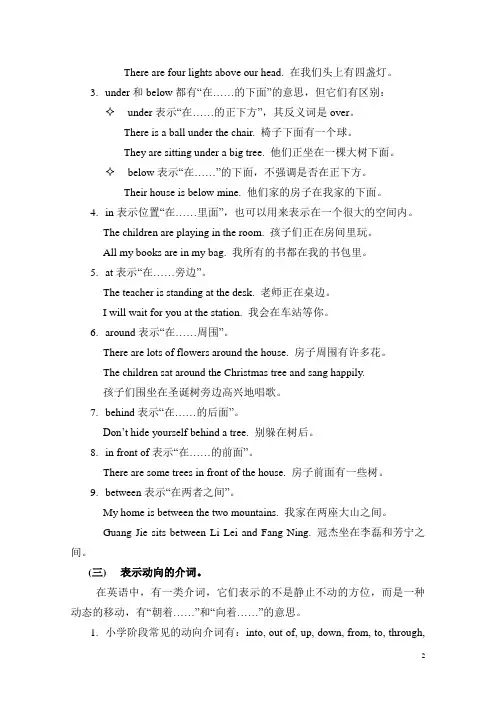
常见介词及用法(一)表示时间的介词1.英语里最常见的时间介词有:at, in, on, before, after和from。
2.at , in和on这三个词都表示时间。
✧at主要指具体的钟点:at half past eight 在八点半✧in一般指某一段时间:in January 在一月份✧on指具体在某一天:on Monday 在星期一3.before和after表示时间的先后顺序。
✧before表示“在……之前”。
You should wash your hands before eating. 吃饭前你应该洗手。
✧after表示“在……之后”。
They often play basketball after dinner. 他们放学后经常打篮球。
4.from作时间介词含有“从……开始”的意思,常和to连用,组成“from…to…”的结构,表示“从……到……”的意思。
We go to school from Monday to Friday. 我们从周一到周五上学。
(二)表示方位的介词,也就是表示位置和地点的介词。
1.小学阶段常见的方位介词有:on, in, at, under, over, above, below, about,around, between等。
2.on, over和above这三个词都有“在……上面”的意思,但它们所表示的方位还是有些不同。
✧on表示两个物体的表面相互接触。
如:There is a book on the desk. 桌上有一本书。
The boy is sleeping on the desk. 那个孩子睡在地上。
✧over表示“在……的正上方”,两个物体表面没有接触。
如:There is a light bulb over my head. 在我头顶上有一个灯泡。
✧above表示两个物体中一个在另一个的上方,如:The plane is flying above the clouds. 飞机上云层上飞行。
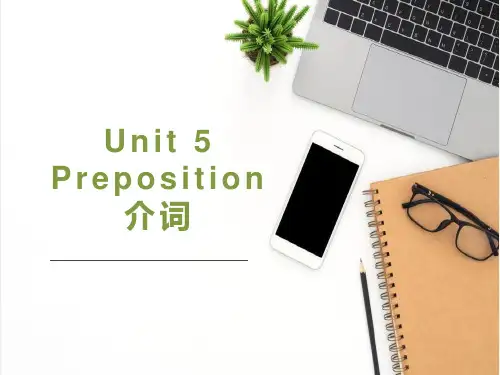
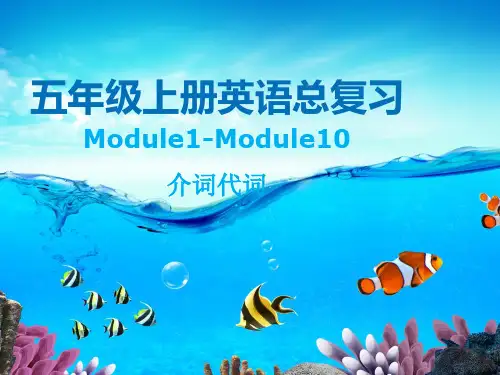
介词介词(是preposition,简称prep.),又称前置词,是英语中最活跃的词类之一,连接主语和表语。
特别是一些常用介词的搭配力特别强,可以用来表示各种不同的意思。
英语里大部分习语都是由介词和其他词构成的。
介词在句中一般不重读。
在定语从句“介词+whom/which”的结构中,不能用that 代替whom/which(不能是who)。
She is a good student from whom we should learn.一、介词at,in与on在时间方面的用法●at表示时间的一点;He goes to school at seven o’clock in the morning. 他早晨七点上学。
●in表示一个时期;Can you finish the work in two days. 你能在两天内完成这个工作吗?●on表示特殊日子。
Linda was born on the second of May. 琳达五月二日出生。
1. at后常接几点几分,天明,中午,日出,日落,开始等。
如:at five o’clock (五点),at down (黎明),at daybreak (天亮),at sunrise (日出),at noon (中午),at sunset (日落),at midnight (半夜),at the beginning of the month (月初),at that time (那时),at that moment (那会儿),at this time of day (在一天的这个时候)。
2. in后常接年,月,日期,上午,下午,晚上,白天,季节,世纪等。
如:in 2006(2006年),in May,2004 (2004年五月),in the morning (早晨/上午),in the afternoon (下午),in the evening (晚上),in the night (夜晚),in the daytime (白天),in the 21st century (21世纪),in three days (weeks/month)三天(周/个月),in a week (一周),in spring (春季)。
小学英介介( Preposition )一、概括介是英中很活的,一般置于名以前。
它常和名或名性组成介短。
同一个介常和不一样的搭配形成固定搭配,表示不一样意。
二、常用介的基本用法at①表示:I go to school at seven every day我每日清晨7 点去上学。
②表示在某一详细地址:He is standing at the bus stop他站在公共汽站。
③表示作的方向、目:Let me have a look at the picture我看看幅。
④用于某些固定搭配:at once 马上、上at last 最后at the same time同at first开始not at all一点也不about①表示大:I's about six o'clock now.在大 6 点了。
②表示地址;在⋯⋯周:Everthing about me is so beautiful我周的全部都那么美好。
③对于,于:We are talking about the news.我正在新。
after①在⋯⋯以后:After dinner I watch TV.晚后我看。
②在⋯⋯后边:He came into the room after me.他在我后边了房。
behind①在⋯⋯以后:There is a bike behind the tree.后有一自行②比⋯⋯晚,于:The train is behind time.火晚点了by①在⋯⋯旁:He is sitting by the bed.他正坐在床。
②到⋯⋯ 候:We have learned three English songs by now.到在止,我已学会了三首英文歌曲。
③以⋯⋯方式:I go to school by bus.④用于某些固定搭配:one by one 我乘公共汽去上学。
一个接一个by the way便一句for① ,,替:I'll make a card for my teacher.我要老做卡片。
小学英语常考介词介词一般置于名词之前,它常和名词或名词性词语构成介词短语。
同一个介词和不同的词语搭配形成固定搭配,表示不同的意义。
一、常考时间介词at,on,in时间介词at,on,in后面都可以接表示时间的词,但用法又有所不同。
1、时间介词at的用法:(1)at+具体时刻/时间点。
如:at six o'clock ;at a quarter to eight ;at half past nine(2)at+某个时段。
如:at noon/night ;at weekends(3)at+节日。
如:at Christmas(4)at+年龄。
如:at ten/at the age of ten例:Peter usually gets up at 7 o'clock in the morning.PeterThe clock strikes twelve times at noon.We'll see you at Christmas.She left her hometown at fourteen.(1)on+星期。
如:on Monday ;on Friday(2)on+具体日期。
如:on May 21st(3)on+具体某天的上午/下午/晚上。
如:on Saturday evening on the morning of May 21st例:We have an English class on Thursday.Mike's birthday is on March 9th.They will have a football game on the afternoon of April 11th.3、时间介词in的用法:(1)in+上午/下午/晚上。
如:in the morning/afternoon/evening(2)in+月份、季节、年份。
如:in October ;in spring ;in 2015(3)in+年龄。
小学英语介词用法1、小学英语介词at,in与on在时间方面的用法at表示时间的一点;in表示一个时期;on表示特殊日子。
如:He goes to school at seven o’clock in the morning. 他早晨七点上学。
Can you finish the work in two days. 你能在两天内完成这个工作吗?Linda was born on the second of May. 琳达五月二日出生。
1). at后常接几点几分,天明,中午,日出,日落,开始等。
如:at five o’clock (五点),at down (黎明),at daybreak (天亮),at sunrise (日出),at noon (中午),at sunset (日落),at midnight (半夜),at the beginning of the month (月初),at that time (那时),at that moment (那会儿),at this time of day (在一天的这个时候)。
2). in后常接年,月,日期,上午,下午,晚上,白天,季节,世纪等。
如:in 2006(2006年),in May,2004 (2004年五月),in the morning (早晨/上午),in the afternoon (下午),in the evening (晚上),in the night (夜晚),in the daytime (白天),in the 21st century (21世纪),in three days (weeks/month)三天(周/个月),in a week (一周),in spring (春季)。
3). on后常接某日,星期几,某日或某周日的朝夕,节日,及有修饰语修饰的下午、晚上等。
如:on Sunday (星期日),on a warm morning in April (四月的一个温暖的上午),on a December night (12月的一个夜晚),on that afternoon (那天下午),on the following night (下一个晚上),on Christmas afternoon (圣诞节下午),on October 1,1949 (1949年10月1日),on New Year’s Day (新年),on New Year’s Eve (除夕),on the morning of the 15th (15日的早上)等。
介词一般置于名词之前。
它常和名词或名词性词语构成介词短语。
一、表达时间旳介词注意:不用介词表达旳词组:this year; this morning; last night; last summer; next Sunday;yesterday; tomorrow如:Did you do your homework last night?I am going to Beijing next Sunday.What are you going to do this afternoon?三、方位介词三、表达地点位置旳介词1. at+小地方:at home; at school; at the bus stop; at the library;2. in+大地方:in China; in Zhaoqing;四、固定搭配1. listen to---听write to----写; look at-----看;Please listen to me. 请听我讲。
I will write to you later. 我晚点会写信给你旳。
Please look at the picture 让看着这幅图。
2. in +科目:in English: What's this in English? 这用英语怎么说?in black clothes 穿黑色衣服3. for +动词ing: Thank you for helping me. 谢谢你帮我。
for+某人:I'll make a card for my teacher. 我要给老师做张卡片。
for+早午晚餐:It’s time for breakfast. =It’s time to have breakfast.4. about1) 大概:It’s about six o'clock now. 目前大概6点钟了。
2) 有关:We are talking about the news. 我们正在谈论新闻。